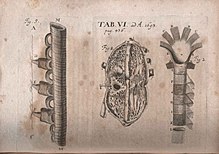Philip Verheyen
Philip Verheyen (born April 23, 1648 in Verrebroek , † January 28, 1710 in Leuven ) was a Flemish surgeon, anatomist and author.
He was born the third of seven children in Verrebroek , in what is now Belgium , (probably in his parents' house, which was on their property in an area called "Borring", near the border with Meerdonk), his parents Thomas Verheyen and Joanna Goeman. He was baptized in the parish church in Verrebroek on April 24, 1648. All that is known about his childhood is that he worked as a cowherd and learned to read and write in the local parish school. Locals say that he had such an excellent memory that he was able to repeat the pastor's sermons after Sunday mass.
The village pastor took him into his care and sent him to Leuven in 1672, where he attended the Collegium Sanctae Trinitatis (Trinity College ) of the old University of Leuven for 3 years .
After completing his studies in the liberal arts in 1675, Verheyen studied theology with the intention of following in his mentor's footsteps and becoming a priest. Doom forced him to amputate his left leg so that he could not become a priest. This event was of great importance for the rest of his life.
He then embarked on a medical career, initially continued his studies at the Trinity College and studied in Leiden from 1681 to 1683. In 1683 he returned to Leuven and received a doctorate in medicine. He lectured in anatomy and surgery and practiced as a doctor. As a result of his numerous publications, he earned a high reputation for a short period at home and abroad. In 1693 his first publication of his Corporis Humani Anatomia appeared .
Philippe Verheyen died in November 1710 and was buried in the cemetery of St. Michael's Church in Leuven. Before his death, he gave instructions to bury his body outside the cemetery so as not to infect the building with " unhealthy fumes ".


In 1862 his place of birth, Verrebroek, organized a commemoration of his life and work.
Origin of the name Achilles tendon
The name of the largest and strongest human tendon goes back to Verheyen, which he referred to in his work in 1693 as the “strand of Achilles”. A German surgeon later changed this to ' Achilles tendon '.
Individual evidence
- ↑ Suy, Raphael ME: Philip Verheyen (1648-1710) and his Corporis Humani Anatomiae . In: Acta Chir Belg . 2007. Retrieved January 28, 2015.
- ↑ Pollier Green, Pascale: Confronting Mortality with Art and Science . Asp, 2008, p. 76.
- ↑ a b LINDEBOOM, Dutch medical biography, p. 2046
- ↑ Emory, John: The Works of the Reverend John Wesley, AM . Methodist Episcopal Church, 1831, p. 583 .
- ↑ HOORNAERT, Louis, Philip Verheyen verheerlijking (1863), p. 15th
- ^ Karenberg, Axel: Specialized language medicine in a crash course: for studies and professional practice . Schattauer, 2007, p. 64.
| personal data | |
|---|---|
| SURNAME | Verheyen, Philip |
| BRIEF DESCRIPTION | Flemish surgeon, anatomist and author |
| DATE OF BIRTH | April 23, 1648 |
| PLACE OF BIRTH | Verrebroek |
| DATE OF DEATH | January 28, 1710 |
| Place of death | Leuven |

